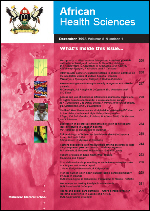
|
African Health Sciences
Makerere University Medical School
ISSN: 1680-6905
EISSN: 1680-6905
Vol. 20, No. 1, 2020, pp. 114-121
|
 Bioline Code: hs20016
Bioline Code: hs20016
Full paper language: English
Document type: Review Article
Document available free of charge
|
|
|
African Health Sciences, Vol. 20, No. 1, 2020, pp. 114-121
| en |
Magnitude of Cryptococcosis among HIV patients in sub-Saharan Africa countries: a systematic review and meta-analysis
Alemayehu, Tsegaye; Ayalew, Sosina; Buzayehu, Temesgen & Daka, Deresse
Abstract
Background: Cryptococcus is encapsulated opportunistic yeast that causes life threatening meningoencephalitis of patients with human immunodeficiency virus (HIV). The magnitude of Cryptococcosis among HIV patients varies from 1-10% in Western countries as opposed to almost a one third of HIV-infected individuals in sub-Saharan Africa where it is associated with high mortality.
Methodology: By using key terms “Cryptococcosis among HIV patients in sub-saharan Africa countries”, articles that published in different journals from 2010-2017 searched on Pub-Med and Google scholar database. Those freely accessible and included the prevalence of Cryptococcosis in the result section, their PDF file was downloaded and the result extracted manually and presented in table. Articles that did not report the prevalence of Cryptococcosis, with a study design otherthan cross sectional, or a sample size less than 100, and those duplicated in the same study area and period by the same authors were excluded. The article selection followed the PRISMA guidelines and meta- analysis was performed using OpenMeta(analyst).
Results: The overall pooled magnitude of Cryptococcosis among HIV patients in sub saharan African countries was 8.3% (95%CI 6.1-10.5%). The highest prevalence was from Uganda (19%) and the least was from Ethiopia at 1.6%. There was 87.2 % of substantial heterogeneity among the studies with p-value<0.001. The symmetry ofthe forest plot showed that there was little publication bias. The most commonly used method for diagnosis of Cryptococcosis was lateral flow assay and latex agglutination test and culture was the least method employed.
Conclusion: The overall pooled magnitude of Cryptococcosisis high among HIV patients in sub-Saharan African countries. The studies showed substantial heterogeneity, and little publication bias. Most of the studies relied on LFA & LA that showed the scarcity of facilities for fungal culture. Therefore, paying attention to screening HIV patients; those with signs and symptoms of meningitis may help to reduce the loss of HIV patients.
Keywords
Cryptococcosis; sub-Saharan African; HIV; meta-analysis.
|
| |
© Copyright 2020 - Alemayehu T et al.
|
|
